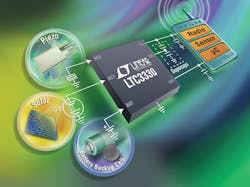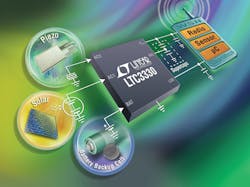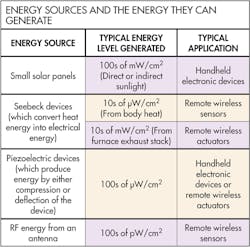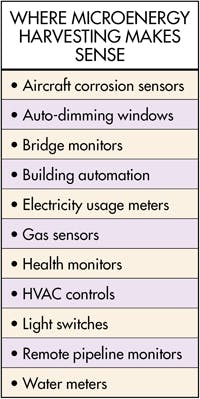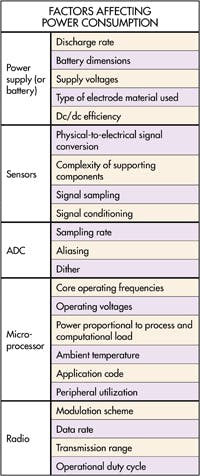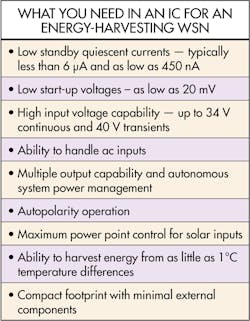Harvesting energy for wireless sensors
Engineers have been harvesting energy for centuries, first using water and windmills, then hydroelectric dams, solar panels, and geothermal plants. Now some engineers are following physicist Richard Feynman’s advice and thinking small. They are using tiny solar panels and thermoelectric generators to glean power from seemingly insignificant temperature differences, piezoelectric elements that convert small mechanical vibrations into power, and galvanics that only need moisture to create electricity.
The amount of power can be small — measured in microwatts — and they don’t usually generate power 24/7. But the ambient energy sources they use, including light, heat differentials, vibrating beams, transmitted RF signals, and others, provide that small amount of power for free. (See Energy Sources and the energy they can generate.)
These so-called wireless-sensor nodes (WSN) let designers place self-powered sensors in difficult-to-access or dangerous locations, without worrying about routing power or data lines, and still receive real-time parameter updates.
WSN issues
In general a WSN consists of a sensor, transceiver, microcontroller, and a transducer that transforms local ambient energy into electricity. Ones that use little power are best. There’s also usually a dc/dc converter and power manager that supplies the right voltage levels and current to the electronics.
So one of the first questions engineers designing WSNs need to answer is: How much power does the WSN need to operate? The answer depends on several factors. For example, how often do readings need to be taken? And how much data will be sent out and how far will it be transmitted?The amount of electricity provided by energy-harvesting sources depends on how long they have access to the ambient energy. Solar cells need sunlight. And piezoelectric devices that turn vibrations from cars going over a nonsuspension bridge into power need traffic crossing the bridge. Therefore, the primary measure for comparing energy harvesting (or scavenging) is power density, not energy density.
Energy harvesting is generally subject to low, variable, and unpredictable levels of available power, so a hybrid structure connecting the harvester and a power reservoir is often needed. It lets the harvester act as the WSN power supply even though power is not continually generated. The power reservoir, either a battery or capacitor, supplies power when required but otherwise gets regularly charged from the harvester. Thus, when there is no ambient energy to harvest, the reservoir must power the WSN.
Of course, from a designer’s perspective, this adds a further degree of complexity because he must now consider how much energy must be stored in the reservoir to compensate for the lack of ambient energy. Just how much a WSN requires depends on several factors. These include:
• The length of time ambient energy is unavailable.
• The WSN’s duty cycle (how often it makes data readings and transmissions).
• The size and type of reservoir (capacitor, supercapacitor, or battery).
• Whether there is enough ambient energy to power the WSN readings and transmissions and charge the reservoir.
WSN costs and pricing
The Cost of a WSN depends on several factors, but how many WSNs are being bought could be the most important. The other major factor is the type of sensor or transducer being used since the electronics are relatively low cost. The dc/dc converter, microcontroller, and transceiver can cost as little as $12 in volume. The LTC330EUH is priced at $3.55 if you're purchasing 1,000 of them. However, thermal-electric generators and piezoelement can cost $30 to $50 in lots of 1,000, depending on the size and power output. In larger volumes, the price should go down, possibly by half. In general, a single WSN can be built for $30, in volume. But after manufacturing and assembly, marketing, and being sold at a profit, the price can easily fall into the $100 to $150 range.
The power link
WSNs usually must make do with low levels of energy. Therefore, their components have to deal with those power levels. Fortunately, the design and engineering work has already been done with regard to transceivers and microcontrollers. But on the power-conversion side of the equation, there has been a void. That’s why Linear Technology Corp., Milpitas, Calif., recently introduced its LTC3330 to specifically address this requirement.
The LTC3330 delivers up to 125 mA of continuous output current to extend battery life when harvestable energy is available. The chip draws no supply current from the battery when providing regulated power to the load (sensor) from harvested energy. It only draws 750 nA when powered by the battery under no-load conditions. The IC combines a high-voltage energy-harvesting power supply and a synchronous buck-boost dc/dc converter when powered by a primary cell battery. This creates a single noninterruptible output for WSNs.
The LTC3330’s power supply consists of a full-wave bridge rectifier that accommodates ac and dc inputs and an efficient buck converter. It can help in scavenging energy from piezoelectric (ac), solar (dc) and magnetic (ac) devices. The primary cell input powers the converter which operates on 1.8 to 5.5 V at its input. It can be used when there is no harvestable energy to regulate the output whether the input is above, below, or equal to the output.
Portable applications and energy-harvesting devices accept a broad range of power levels for their operation, from microwatts to greater than 1 W, so there are many power-conversion ICs on the market. However, at the lower end of the power range, where nanoamps of currents need to be converted, chip choices are limited.
The LTC3330 energy harvester and battery-life extender, with its extremely low quiescent current, is well suited for low-power applications. A quiescent current of less than a microamp prolongs battery life for keep-alive circuits in portable electronics, which will open the door for a new generation of WSNs and other energy-harvesting applications.
